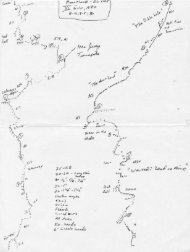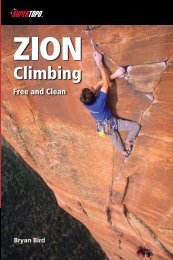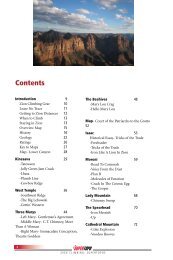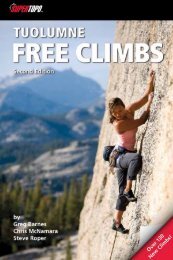The Definitive Guide To Yosemite Big Wall Climbing - SuperTopo
The Definitive Guide To Yosemite Big Wall Climbing - SuperTopo
The Definitive Guide To Yosemite Big Wall Climbing - SuperTopo
You also want an ePaper? Increase the reach of your titles
YUMPU automatically turns print PDFs into web optimized ePapers that Google loves.
Aid <strong>Climbing</strong> Ratings<br />
Grade Ratings<br />
Grade ratings give a sense of the overall<br />
commitment required on a climb. Grades I and<br />
II refer to short crag routes. <strong>The</strong>se ratings are<br />
seldom used.<br />
Grade III refers to half-day routes. Examples:<br />
Royal Arches, Nutcracker.<br />
Grade IV refers to full-day routes. Example: East<br />
Buttress of El Cap.<br />
Grade V refers to shorter big wall routes. Fast<br />
parties may only take a day, but most parties<br />
spend two to three days on the wall. Examples:<br />
West Face of Leaning <strong>To</strong>wer, Prow, South Face<br />
of Washington Column.<br />
Grade VI refers to longer big wall routes. All<br />
but the fastest teams require at least two days<br />
and usually many more. Examples: Regular<br />
Northwest Face of Half Dome, all routes on<br />
El Capitan.<br />
Grade VII refers to extreme alpine big walls<br />
that require at least ten days of suffering on a<br />
huge wall in poor weather in a remote area.<br />
Examples: Great and Secret Show, Baffin Island;<br />
Grand Voyage, Great Trango <strong>To</strong>wer, Pakistan.<br />
Aid Ratings<br />
Keep in mind that aid ratings are only one<br />
measure of the difficulty of a wall climb.<br />
Weather, the length of the climb, skill, physical<br />
condition of the climber, the number of<br />
previous ascents, approach and descent, and<br />
many other factors all combine to determine<br />
the overall difficulty of a wall. Pitch ratings also<br />
can’t include the dangers of bad bolts and poor<br />
fixed gear. Bolt ladders on some routes, which<br />
18<br />
YOSEMITE BIG WALLS SUPERTOPOS<br />
are theoretically “A0,” have scored many 30- to<br />
50-foot falls when rivets broke. <strong>Big</strong> airtime has<br />
also been logged on <strong>The</strong> Groove pitch of <strong>The</strong><br />
Shield when numerous fixed pieces pulled.<br />
Question fixed gear and be prepared if it pulls.<br />
Aid ratings are based on the number of<br />
bodyweight placements in a row. How is a<br />
“bodyweight” placement differentiated from a<br />
“bomber” placement? <strong>The</strong> only way to know<br />
for certain is to take a fall. <strong>The</strong> next best way to<br />
find out is to ask yourself, “Would I belay off<br />
this?” If the answer is “no” then it is probably a<br />
bodyweight placement.<br />
A0 Pulling on pieces for progress while in free<br />
climbing mode. Generally no aiders are used<br />
unless you are climbing a bolt ladder.<br />
A1 or C1 Easy aid: All placements are bomber.<br />
Little danger of falling except through pilot<br />
error. Most C1 pitches take from one to two<br />
hours. Examples: Many pitches on Half Dome’s<br />
Regular Route, <strong>The</strong> Nose, and South Face of the<br />
Column.<br />
A2 or C2 Moderate aid: one or two bodyweight<br />
placements over bomber gear. Five- to 30-foot<br />
fall potential. Examples: Many pitches on<br />
Zodiac, Prow, and Direct on Half Dome. Most<br />
C2 pitches take one to three hours.<br />
A3 or C3 Hard aid: Three to five bodyweight<br />
placements in a row. Thirty- to 50-foot fall<br />
potential. Examples: Many pitches on Pacific<br />
Ocean <strong>Wall</strong>, Mescalito, and Ten Days After.<br />
Most C3 pitches take two to three hours.<br />
A4 or C4 Serious aid: Six to eight bodyweight<br />
placements in a row and a 50- to 80-foot fall<br />
potential. Examples: Many pitches on Sea of<br />
Dreams, Atlantic Ocean <strong>Wall</strong>, and Native Son.<br />
Most C4 pitches take more than three hours.
















